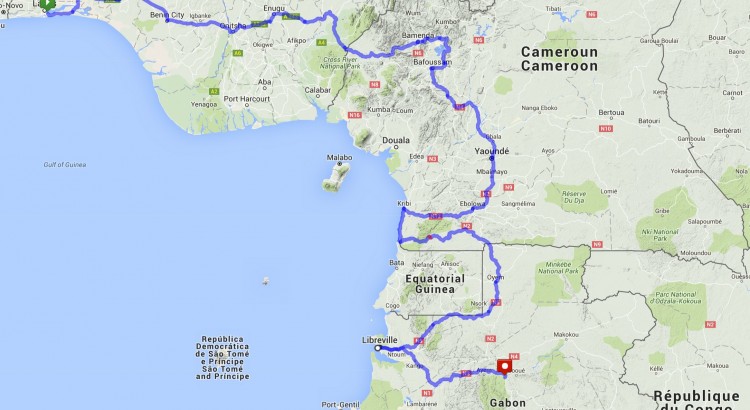Leg 2 of what now seems to become a Tour d’Afrique is finished. We’ve been back in the civilisation now for a week and the final traces of red African dirt are leaving the lungs, nostrils, hair and other bodily hiding places.
The bikes are stored in Libreville, waiting for the opportunity to present itself to continue to trip south to the Congo river jungle, steppes of Angola towards the deserts of Namibia.
Route
We covered 3200km on the bikes, of which 60% was tarmac and 40% dirt. As the speeds on dirt average to about 1/3rd of the tarred speeds, it turns out we spent almost 70% of the riding time on dirt and 30% on tarmac.
In the grand scheme of what is Africa – this was a pretty local event.
The choice of the route was not overly pre-meditated, we looked at the map as we went along, chose the routes and detours that seemed more interesting and didn’t do a whole lot of research about sights to see. In retrospect could have planned a tiny bit more.
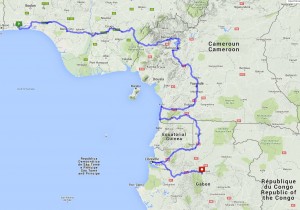 Having a tent and carrying sufficient food for tea, light supper and breakfast gave us freedom to camp whereever we liked and didn’t bind us to reaching towns before nightfall nor hotel reservations. It was also cheap as nothing. We carried a pot for cooking, but never got to putting it to use.
Having a tent and carrying sufficient food for tea, light supper and breakfast gave us freedom to camp whereever we liked and didn’t bind us to reaching towns before nightfall nor hotel reservations. It was also cheap as nothing. We carried a pot for cooking, but never got to putting it to use.
Sleeping wild means that you get into the rhythm of the local bush life. The authentic song and dance in the nearby village after nightfall, chatting with the hunter-gatherers, who pass your campsite in the dawn over tea as they’re heading to the jungle.
Motos
Kotilda (12y) and Suusi (15y) aren’t in their first youth any more, but they survived almost without a hickup. We should have carried a few spare bolts and nuts in different sizes as you’re guaranteed to lose a few in the rattle of the dirt roads.
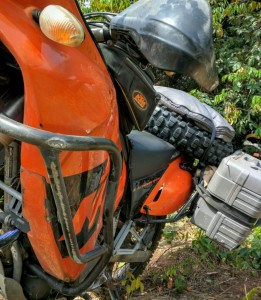 Useful extras: tank bars on Kotilda, I would have certainly smashed the tank otherwise. I had plastic Hepco Gobi pannier cases held up by straps. Juka had soft Orblitz waterproof bags, adapted from a touring bicycle. When riding and navigating through traffic I was jealous for Juka’s small pannier bags, in the evenings by tea I noticed envy in his eyes when I could use one of my boxes for seating. I had enough luggage only to fill one of the cases, while the other was almost empty as was my tank bag.
Useful extras: tank bars on Kotilda, I would have certainly smashed the tank otherwise. I had plastic Hepco Gobi pannier cases held up by straps. Juka had soft Orblitz waterproof bags, adapted from a touring bicycle. When riding and navigating through traffic I was jealous for Juka’s small pannier bags, in the evenings by tea I noticed envy in his eyes when I could use one of my boxes for seating. I had enough luggage only to fill one of the cases, while the other was almost empty as was my tank bag.
 We wore the legendary Pirelli MT21 rallycross tyres, which were very convenient on the dirt roads, but burning fast on tarmac and not so good grip when braking at high speeds.
We wore the legendary Pirelli MT21 rallycross tyres, which were very convenient on the dirt roads, but burning fast on tarmac and not so good grip when braking at high speeds.
Other than Kotilda clutch and brake hydraulics and Suusi tyres, the only serirous mechnical issue was in the last day when I had parked Kotilda leaning at an angle, such that a reservoire of torrential rain gathererd around the tank plug and seeped into the tank and onto the carburettor.
Supplies
It’s not worth bringing too much with you. I’ll try to list what we carried in the order of importance:
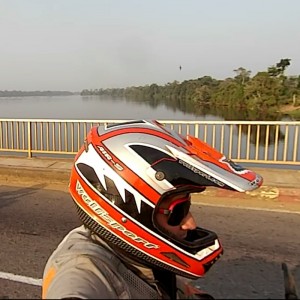 Motocross helmet and sunglasses combo. I find that sunglasses give better visibility than a dirty scratchy visor and they are easier to replace if they get scratched. The shades didn’t quite protect from the dirt though, perhaps should have taken a pair with a bolster. Last time I carried motocross goggles, but didn’t wear once because it was clumsy and way too hot.
Motocross helmet and sunglasses combo. I find that sunglasses give better visibility than a dirty scratchy visor and they are easier to replace if they get scratched. The shades didn’t quite protect from the dirt though, perhaps should have taken a pair with a bolster. Last time I carried motocross goggles, but didn’t wear once because it was clumsy and way too hot.- Rev’it jacket. Removed all linings and opened all possible ventilation patches. In the boiling heat I developed the proficiency of removing the helmet and jacket in around 1400ms after the bike had stopped.
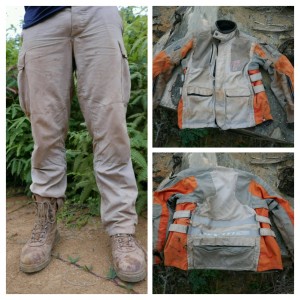 British army cargo pants and boots. Both desert series from around 2005. Perfect.
British army cargo pants and boots. Both desert series from around 2005. Perfect.- Knife. Bring a good sharp knife both for fixing things and for perceived protection against jungle animals and rookie robbers.
- Tent, mat and very light sleeping bag or a blanket.
- Tablet and keyboard. Did some occasional blogging and emails in the tent after dark. Also useful to install a USB charger to the bike.
- Cameras. Had a RE for shooting video clips and taking undercover shots. An LX-100 camera for higher quality snaps. Carried a GoPro too, but didn’t use it for anything other than timelapses. I used Google Photos to merge 10 sec clips into 1min movies, BatchConverter and PicPac to create timelapses. Juka had a decent SLR for real pics.
- Local SIM cards w/ data. Very easy to get.
- Google Maps. Forgot to get a paper map upfront and there was nothing in Nigeria and Cameroon. Google was okay in Nigera and Cameroon, but seriously off in Gabon.
- Selection of spanners, screwdrivers, pliers, electrical tester.
- Spare heavy duty tubes, spark plugs. Also carried spare rear tyres for the first 1000km. For longer travels it would be useful to take a new chain and oil filters.
- Two spare t-shirts and a pair of shorts. A spoon, a toothbrush.
A pretty comprehensive list, couldn’t have optimised much more. No need to carry too much.
Costs
In EUR per bike/person
€200 Shipping and box
€1000 Nigeria customs
€300 Visas
€1100 Flights
€200 Hotels (8 nights)
€150 Petrol
€500 Food, fun, fixes and everything else (5 weeks)
€0 Bribes (excl Nigeria customs)
Altogether €3450 (2600 GBP) per person isn’t a small amount of money, but then again for a 5 week adventure isn’t too bad either.
What next?
The bikes are stationed in Libreville – I asked the local shop owner parking for 6-12mo, but I’m sure he realised I really meant 12-24mo, perhaps more.
In the next leg I would love to make it to Windhoek, Namibia to meet one of my old friends, who lives there. Unfortunately it is nearly 6000km of riding – about 30 days. The route would go through the slightly scary but über-exciting Congos, then through the portuguese Angola which is vast. Would also want to check out the surfing hippos in the Luango Park in Gabon on the way and get to Namibia’s Skeleton Coast.
Juka is pretty eager to go as soon as he gets to sell some of his paintings and accumulate cash. He doesn’t really care if he is spending his time in the forests of Jõgevamaa or in the forests of Congo. I will struggle finding 30 consecutive days soon for the next expedition. May be we split it in two, or maybe someone wants to do a bit of riding with Kotilda for some of the distance.
Weather is another challenge. The long dry season is Jun-Sep in Congo and Angola, the short dry in Feb-Mar is also possible, but there is a good chance of rain, which makes many roads impassable and is just a bit of a nuissance.
There will be a way.
